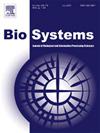CikA和SasA共同调控对蓝藻生物钟的影响
IF 1.9
4区 生物学
Q2 BIOLOGY
引用次数: 0
摘要
蓝藻生物钟由三种蛋白质组成:KaiA、KaiB和KaiC。KaiA与a环结合激活KaiA的自磷酸化,而KaiB将KaiA与a环隔离,从而减弱KaiA的活性。因此,产生了KaiC磷酸化的昼夜节律振荡器。最近的实验发现,CikA和SasA在蓝藻生物钟中都起着至关重要的作用。它们参与输出通路,调控核心振荡器转录因子的活性。然而,CikA和SasA的监管对该系统的具体影响仍远不清楚。为了解决这些问题,我们开发了一个扩展的蓝藻生物钟数学模型,包括CikA和SasA调节。数值模拟结果表明,CikA和SasA对系统的作用相反,两者相互补充,维持系统的平衡。具体来说,随着SasA浓度的增加,周期和幅度增大,周期对参数的敏感性、暗脉冲引起的相移和夹带能力均降低。CikA的规定对上述方面产生了相反的影响。根据这些结果,我们可以通过调整CikA或SasA的浓度来调整系统的某些指标。本文的研究方法可以为研究其他蛋白质对生物钟的影响提供思路。研究结果对生物学研究有补充作用,为生物学研究提供理论参考。这有助于我们对蓝藻生物钟的动态机制有更深入的了解。本文章由计算机程序翻译,如有差异,请以英文原文为准。
Effects of CikA and SasA co-regulation on cyanobacterial circadian clock
Cyanobacterial circadian clock is made up of three proteins, KaiA, KaiB and KaiC. KaiA binds to the A-loop to actives the autophosphorylation of KaiC, while KaiB sequesters KaiA from the A-loop to weaken the activity of KaiA. Thus a circadian oscillator of KaiC phosphorylation generates. Recent experiments have found that CikA and SasA both play crucial roles in cyanobacterial circadian clock. They participate in the output pathway and regulate the activity of transcription factors of the core oscillator. However, the specific impact of the regulation of CikA and SasA on the system is still far from clear. To address these questions, we develop an extended mathematical model for cyanobacterial circadian clock including CikA and SasA regulation. The numerical simulation results indicate that CikA and SasA have opposite effects on the system, and the two complement each other to maintain the balance of the system. Specifically, as the concentration of SasA increases, the period and amplitude increase, and the period sensitivity to parameters, phase shift caused by dark pulses and entrainment ability are all decrease. The regulation of CikA has the opposite impact on the above aspects. Based on these results, we can adjust certain indicators of the system by adjusting the concentration of CikA or SasA. The research method in this article can provide ideas for studying the effects of other proteins on the circadian clock. The findings supplement biological studies and provide a theoretical reference for biological research. It helps us gain a deeper understanding of the dynamic mechanism of cyanobacteria circadian clock.
求助全文
通过发布文献求助,成功后即可免费获取论文全文。
去求助
来源期刊

Biosystems
生物-生物学
CiteScore
3.70
自引率
18.80%
发文量
129
审稿时长
34 days
期刊介绍:
BioSystems encourages experimental, computational, and theoretical articles that link biology, evolutionary thinking, and the information processing sciences. The link areas form a circle that encompasses the fundamental nature of biological information processing, computational modeling of complex biological systems, evolutionary models of computation, the application of biological principles to the design of novel computing systems, and the use of biomolecular materials to synthesize artificial systems that capture essential principles of natural biological information processing.
 求助内容:
求助内容: 应助结果提醒方式:
应助结果提醒方式:


